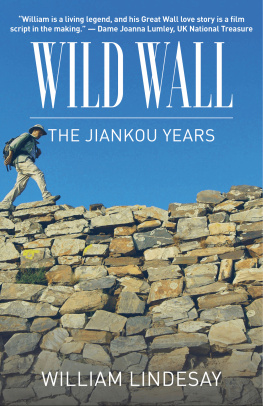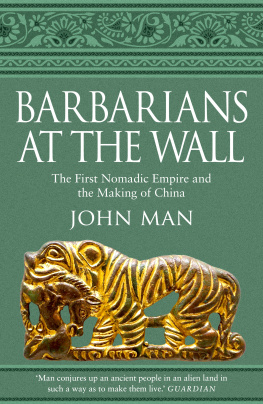Praise for The Great Wall:
Julia Lovell, a don at Cambridge, has had the idea of telling the story of China over three millennia through the history of the Great Wall. Given her own strictures for what she calls wall-worship, it is a risky endeavor, but Ms. Lovell more than pulls it off.... Her account of both its construction and purpose involve a healthy dose of demythologizing.... [Lovell has] a brisk and confident style. Her book works well, both as an introduction to Chinese history and as a study of one of its most evocative aspects.
George Walden, The Daily Telegraph
[An] engaging history of Chinas most famous cultural edifices, the symbol of its past and a metaphor for its future. British author and historian Julia Lovell explains what the Great Wall of China is, what it is not, and how it got to be that way. Like the wall itself, its a long story. Happily for readers, Lovell is uniquely qualified to tell it. A translator of Chinese as well as a historian, Lovell is a lively writer.... Her history of the Chinese worldview uncovers what makes the wall uniquely Chinese, as natural an expression of that countrys spirit as the interstate freeway system is of ours.
Philip Herter, St. Petersburg Times
Julia Lovell turns the wall into a moving metaphorical target to trace Chinas oscillation between openness and enclosure over three thousand yearsor, if you like, between engaging outsiders or fending them off. Lovells book is an ambitious task.... [The] wall becomes a prop to build an exhilarating tale. Lovells sweep and style propels the story along at a rapid clip, managing to be both erudite and racy at the same time.
Richard McGregor, Financial Times Magazine
Lovell seeks to use the Great Wall as an interpretive device to understand the long sweep of Chinese history, lifting it out of its specific geographical context as an instrument of northern-frontier control and making it stand as a metaphor for the history and destiny of the country as a whole. There is an agreeable iconoclasm at work throughout the book, often insightful and wittily expressed. Few stones are left unturned.... Her treatment of the human foibles and high statecraft at work in the long sweep of Chinas frontier history sheds light on some of the apparent contradictions of contemporary China.
Graham Hutchings, Literary Review
Young British historian Lovell narrates the history of Chinas preeminent national symbol, its Great Wall. Driving her wonderful chronicle of the wall is her will to dispel visitors impressions, shared alike by Richard Nixon and backpacking tourists, that the Great Wall is a continuous construction of great antiquity. Informing readers that though the earliest long walls do date to the Qin dynasty (about 220 BCE), the crenellated, watchtower-crowned marvel of today was built by Ming emperors in the 1600s. Along the way, Lovell instills an appreciation for how the Chinese self-conception of civilized superiority vis-a-vis raiding barbarians of the steppe induced periods of wall-building. Amounting to an overview of imperial and post-imperial Chinese history, Lovells account of the Great Wall is a supremely inviting entree to the country.
Gilbert Taylor, Booklist

In this 1667 engraving, the Jesuit priests Adam Schall (left) and Matteo Ricci (right) hold between them a map of East Asia, featuring an unbroken, uniformly crenellated Great Wall running across north China. It was during the late seventeenth century that, thanks to Jesuit accounts sent back from China to Europe, the myth of a single, ancient Great Wall began to take shape in the West.
THE GREAT WALL
China Against the World
1000 BCAD 2000
Julia Lovell

Copyright 2006 by Julia Lovell
All rights reserved. No part of this book may be reproduced in any form or
by any electronic or mechanical means, or the facilitation thereof,
including information storage and retrieval systems, without
permission in writing from the publisher, except by a reviewer, who may
quote brief passages in a review. Any members of educational institutions
wishing to photocopy part or all of the work for classroom use, or
publishers who would like to obtain permission to include
the work in an anthology, should send their inquiries to
Grove/Atlantic, Inc., 841 Broadway, New York, NY 10003.
First published in Great Britain in 2006 by
Atlantic Books, an imprint of Grove Atlantic Ltd.
Printed in the United States of America
FIRST PAPERBACK EDITION
Library of Congress Cataloging-in-Publication Data
Lovell, Julia, 1975
The Great Wall: China against the world, 1000 BCAD 2000 / Julia Lovell.
p. cm.
Includes bibliographical references and index.
ISBN-10: 0-8021-4297-4
ISBN-13: 978-0-8021-4297-9
1. Great Wall of China (China)History. I. Title: China against the world, 1000 BCAD 2000. II. Title.
DS793.G67L584 2006
951dc22
2005045640
Cartography by Jeff Edwards
Grove Press
an imprint of Grove/Atlantic, Inc.
841 Broadway
New York, NY 10003
Distributed by Publishers Group West
www.groveatlantic.com
07 08 09 10 11 12 10 9 8 7 6 5 4 3 2 1
To my parents
CONTENTS
LIST OF MAPS AND ILLUSTRATIONS
MAPS
ILLUSTRATIONS
Frontispiece: Adam Schall and Matteo Ricci holding a map of East Asia. Athan asius Kircher, China monumentis (Amsterdam: 1667).
First picture section
.
.
.
.
.
Second picture section
.
.
.
.
Third picture section
The author and publishers are grateful to the following for permission to reproduce illustrations: endpapers, frontispiece, 1, 3, 4, 5, 6, 10, 11, 13, 14, 15, 16, 18, 19, 20, 22 by permission of the Syndics of Cambridge University Library; 2, 8, 25, courtesy Daniel Schwartz/Lookatonline, first published in The Great Wall of China (London: Thames and Hudson, 1990, rev. edn 2001); 7, 17, The British Library and the Clarendon Press; 9, Bibliothque nationale de France; 12, Rosamund Macfarlane; 23, Getty Images; 24, Bettmann/CORBIS.
Every effort has been made to contact all copyright holders. The publishers will be glad to make good in future editions any errors or omissions brought to their attention.
ACKNOWLEDGEMENTS
Enormous thanks are due to the editorial team at Atlantic Books. First of all, to Toby Mundy and Angus Mackinnon, for giving me the idea for the book in the first place and for their patient encouragement as I meandered through the writing process; then, once more, to Angus for his exceptionally acute, scrupulous editing of the manuscript. Im also extremely grateful to Clara Farmer and Bonnie Chiang, for their expert managing of the production process, and for the care and attention they have poured into the book; and to Lesley Levene, the books extremely sharp-eyed copy editor. I owe profound thanks as well to my agents, Toby Eady and Jessica Woollard, for their help and encouragement throughout.
I was generously assisted at key moments by a number of scholars and academics: first and foremost, by Sally Church, who solved so many of my classical Chinese traumas, suggested maps and sources, and provided fantastically detailed and constructive criticism of the completed manuscript, thereby saving it from any number of errors. Frances Wood also gave the book an astonishingly precise and close reading, for which I am deeply grateful. Joe McDermott, Roel Sterckx and Hans van de Ven all patiently fielded a stream of inquiries from me about facts and sources, while Charles Aylmer, the exceptional librarian of the Chinese department at the Cambridge University Library, amazed me time and again with his encyclopaedic bibliographical knowledge of any area of Chinese history I asked him about. Ruth Scurr and Hannah Dawson gave me invaluable help and advice on the Enlightenment. Many thanks also to Chee Lay Tan, for help with poetry translations. All errors and shortcomings that remain are of course my own.
Next page
















